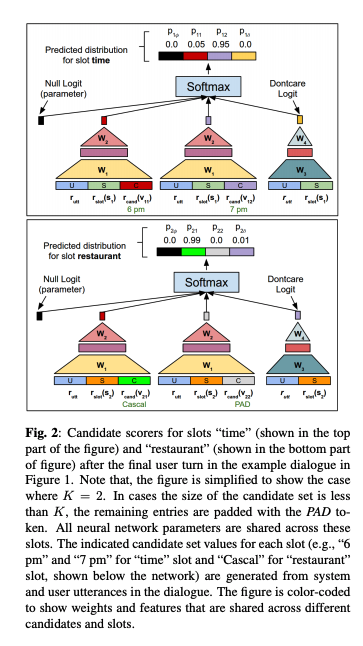Scalable Multi-Domain Dialogue State Tracking
Overview
- The language understanding module outputs are used to delexicalize the user utterances, which are processed by the DST for feature extraction.
- We then integrate a separate candidate generation step that estimates a set of slot value candidates using the local conversation context, as well as possibly external knowledge sources.
- DST operates only on these candidates, resulting in an approach scalable to large and rich datasets.
Architecture
- Model the dialogue state as a joint distribution across all slots and make a simplifying assumption of factoring the joint distribution as a product of a distribution for each slot.
Candidate Set
- Candidate set for a slot is defined as the set of values of that slot, along with the scores.
-
Let \({C_s}^t\) be the candidate set for a turn t of a slot s. \({C_s}^0 is empty for every slot. Limit\) {C_s}^t $$ to K. - Take the candidates for a slot from user utterance, then system utterances and then from the past conversation based on scores (in decreasing order) until you hit K.
State Representation
- To \({C_s}^t\), we add 2 values - null and don’t care. This is the total set of possible values a slot can take.
- We also PAD to keep K constant.
Model Description

- DST is a discriminative model which takes the candidate set for each slot and assigns a score to each of them.
- Feature Extraction
- 3 types of features - utterance, slot and candidate.
- Delexicalization - substituting all the values of slot s with some function delex(s). Just the slot values and not slot names.
- Delexicalized utterance passed through 2-layers of BiLstm and we take the final hidden layer as the utterance representation.
- Utterance related features
- User Utterance and System Utterance.
- User dialog act and System dialog act (global ones ‘greetings’ and ‘negate’ only).
- Slot related features
- Relevant to a particular slot and are common across all candidates for the slot.
- Features - Binary vectors indicating the presence of slot specific dialog act (request or deny) for both user and system. Also include scores of null and don’t care in the previous turn.
- Candidate related features
- Features - Binary vectors indicating the presence of candidate specific dialog act (inform, modify) and the score of candidate in prev turn.
- Also use the utterance feature from the LSTM.
Results
| Paper | Accuracy on DSTC2 |
|---|---|
| This paper | 0.703 |
| Rule-based Baseline | 0.619 |
Kaushik Rangadurai
Code. Learn. Explore
